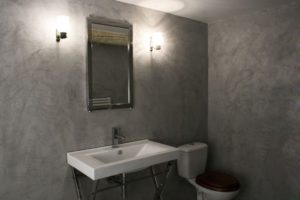 Micro Concrete, otherwise known as Micro Cement, is a popular design product for those who want to create a concrete aesthetic where it would not normally be possible.
Micro Concrete, otherwise known as Micro Cement, is a popular design product for those who want to create a concrete aesthetic where it would not normally be possible.
Read on to discover five things that you need to know about this stunning surface covering if you are involved with design, or are keen to improve the look of your home or workplace.
 1. What is Micro Concrete
1. What is Micro Concrete
Micro Concrete is a cement based coating which can be applied thinly (approximately 2-3mm) to a range of different surfaces to provide the look and feel of concrete at a fraction of the cost and weight of real oncrete. Micro Concrete is an excellent option for kitchens, bathrooms as it provides a hygienic, and stain free surface. What is more, the material is anti-slip and mould free making it a marvelous choice for floor surfaces inside and out.
The inspirational interior design project below shows how versatile the material is, demonstrating that it can be used to cover a range of items in the home including floors, dining room tables, and walls. Also, the image shows how different textural finishes can be achieved.
2. Why is Micro Concrete used?
Micro Concrete was initially developed to reduce the demand for water as compared to conventional concrete. As a result of its ease of use and ability to adhere to other materials, micro concrete was used effectively to repair cracked or ageing concrete structures. Also, no pumping is needed which reduces the requirement of heavy machinery. Not only does this reduce application costs, but it also makes micro concrete a good option for areas with limited access.
Micro Concrete is often used because it can dry quickly which gives designers and those wanting to redecorate their homes with a surface option that will minimally disrupt their other projects. Actually, it dries so quickly that the covered surface could be functional within 1 day.
As Micro Concrete dries so quickly it can be applied one day, and then the item can be used the next making it a super choice for those wanting to get projects done quickly.
This image from Green Hands Screeding demonstrates how sleek micro concrete surfaces look, and also shows how the surface is water resistant and seamless.
 3. What are the main advantages of micro concrete?
3. What are the main advantages of micro concrete?
Micro concrete has numerous advantages over conventional concrete. These include the following;
– Requires no compaction so no heavy machinery is needed,
– Low permeability which means that it is can be used outside and in kitchens and bathrooms
– Bonds well to almost any surface,
– Strong almost as soon as it is applied,
– Chloride free making it a safe and durable surface option,
– Will not shrink upon application which means that no cracks or folds will occur.
4. How is Micro Concrete used?
Micro concrete has been used for various applications, both residentially and commercially. It has been used for items such as kitchen surfaces and shelves as it provides a seamless, durable and contemporary finish.
It is durable and can be applied easily to surfaces internally and externally. As a result, micro concrete is a great option for those who looking to add an affordable hard wearing concrete aesthetic to floors or walls anywhere. It is also a waterproof material and therefore it makes for an ideal covering option for bathrooms and splash backs in kitchens.
Micro Concrete is a versatile product that is available in a range of textures, tones and colours.
As a result, micro concrete is a great option for those wanting to offer unique design elements, and a contemporary finish to their applications.
 5. What is the best practice for applying micro concrete?
5. What is the best practice for applying micro concrete?
So before you cover your floors with tile, linoleum or wood, contact us to find out how to decorate your concrete surfaces professionally and what costs you can expect.


